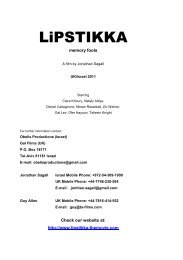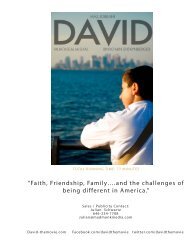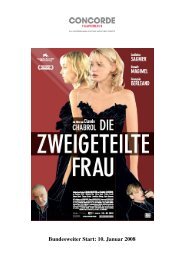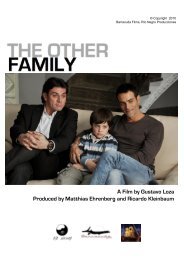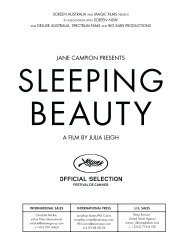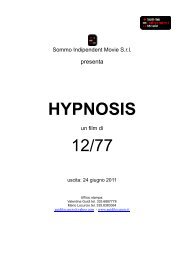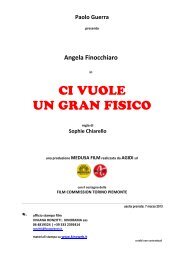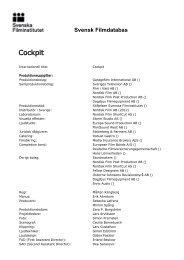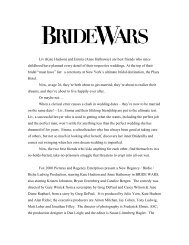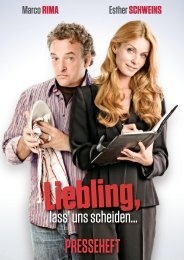Berberian Sound Studio - Press Notes - FDb.cz
Berberian Sound Studio - Press Notes - FDb.cz
Berberian Sound Studio - Press Notes - FDb.cz
You also want an ePaper? Increase the reach of your titles
YUMPU automatically turns print PDFs into web optimized ePapers that Google loves.
Artificial Eye Presents<br />
A Film By Peter Strickland<br />
BERBERIAN<br />
SOUND STUDIO<br />
Starring:<br />
Toby Jones<br />
In Cinemas - August 31st<br />
<strong>Berberian</strong> <strong>Sound</strong> <strong>Studio</strong><br />
Running time: 94 minutes / Certificate: TBC / Images: On request<br />
For further information please contact:<br />
Jake Garriock: Jake.Garriock@artificial-eye.com/ 02074389528
BERBERIAN SOUND STUDIO – PRODUCTION NOTES<br />
Short Synopsis<br />
A sonic descent into the darker recesses of cinema as a naïve sound engineer from<br />
Dorking, UK loses his grip on reality as he takes a job on an Italian horror film in the<br />
‘70s. As actresses overdub one ear-shredding scream after another, and as knives<br />
and machetes repeatedly hack away at innocent vegetables during effects recordings,<br />
Gilderoy has to confront his own demons in order to stay afloat in an environment<br />
ruled by exploitation both on and off the screen.<br />
Long Synopsis<br />
1976: <strong>Berberian</strong> <strong>Sound</strong> <strong>Studio</strong> is one of the cheapest, sleaziest post-production<br />
studios in Italy.<br />
Only the most sordid horror films have their sound processed and sharpened in this<br />
studio. Gilderoy, a naive and introverted sound engineer from England is hired to<br />
orchestrate the sound mix for the latest film by horror maestro, Santini.<br />
Thrown from the innocent world of local documentaries into a foreign environment<br />
fuelled by exploitation, Gilderoy soon finds himself caught up in a forbidding world of<br />
bitter actresses, capricious technicians and confounding bureaucracy.<br />
Obliged to work with the hot-headed producer Francesco, whose tempestuous<br />
relationships with certain members of his female cast threaten to boil over at any<br />
time, Gilderoy begins to record the sound for The Equestrian Vortex, a hammy tale of<br />
witchcraft and unholy murder typical of the ‘giallo’ genre of horror that’s all the rage<br />
in Italy.<br />
Only when he’s testing microphones or poring over tape spooling around his machines<br />
does this timid man from Surrey seem at ease. Surrounded by Mediterranean<br />
machismo and, for the first time in his life, beautiful women, Gilderoy, very much an<br />
Englishman abroad, devotes all his attention to his work.<br />
But the longer Gilderoy spends mixing screams and the bloodcurdling sounds of<br />
hacked vegetables, the more homesick he becomes for his garden shed studio in his<br />
hometown of Dorking.<br />
His mother’s letters alternate between banal gossip and an ominous hysteria, which<br />
gradually mirrors the black magic of Santini’s film.<br />
The violence on the screen Gilderoy is exposed to, day in, day out, in which he himself<br />
is implicated, has a disturbing effect on his psyche. He finds himself corrupted, yet<br />
he’s the one carrying out the violence.<br />
As both time and realities shift, Gilderoy finds himself lost in an otherworldly spiral of<br />
sonic and personal mayhem, and has to confront his own demons in order to stay<br />
afloat in an environment ruled by exploitation both on and off screen.
Production story<br />
The initial idea for <strong>Berberian</strong> <strong>Sound</strong> <strong>Studio</strong> came to Peter Strickland when he heard a<br />
pair of trousers. “A friend of mine had these very noisy trousers and I joked with him<br />
that the noise they made could be a sound effect for thunder,” the film’s writer and<br />
director says. “It started off as a one-minute joke and then the more I got into it the<br />
more personal and exciting it became.”<br />
<strong>Berberian</strong> <strong>Sound</strong> <strong>Studio</strong> is Peter’s second feature. His first, Katalin Varga, a revenge<br />
drama set in the wilds of Transylvania, won a Silver Bear at the 2009 Berlin Film<br />
Festival. For <strong>Berberian</strong> <strong>Sound</strong> <strong>Studio</strong>, in which an English natural history sound<br />
recordist (Toby Jones) goes to Italy to mix a horror film in the 1970s, Peter drew on<br />
his love of experimental film scores, sound effects and analogue recording equipment<br />
to create an elliptical, nightmarish tale that pays tribute to the Italian giallo genre.<br />
Named after the yellow (giallo) covers of the trashy crime novels used for storylines,<br />
this period of cinema in 1960s and 70s Italy produced numerous thrillers and horror<br />
flicks that privileged style over script. As <strong>Berberian</strong> <strong>Sound</strong> <strong>Studio</strong> makes clear, key<br />
ingredients of a typical giallo tended to include girls, daggers, blood, witchcraft and<br />
chilling screams. At the time, directors such as Dario Argento (Profondo Rosso,<br />
Suspiria) and Lucio Fulci (The Black Cat, Zombie Flesh Eaters) commissioned<br />
composers including Ennio Morricone and prog outfit Goblin to score their slasher<br />
films. The title of Peter’s fictional studio, <strong>Berberian</strong>, refers to Cathy <strong>Berberian</strong>, the<br />
versatile American soprano who was married to the Italian electronics pioneer Lucio<br />
Berio, a giant of 20 th century composition. Peter himself has dabbled in sound art and<br />
electronic production as part of the trio The Sonic Catering Band.<br />
Even before it was entered for Berlin, Katalin Varga had impressed the producer Keith<br />
Griffiths (Uncle Boonmee Who Can Recall His Past Lives, Little Otik, Institute<br />
Benjamenta), who’d encountered a rough cut of the film while consulting for the<br />
Locarno Film Festival. He rang Peter to express his admiration and had soon shaken<br />
hands with the director and agreed to work on his next project, <strong>Berberian</strong> <strong>Sound</strong><br />
<strong>Studio</strong>, the treatment for which was already well developed. When Robin Gutch, MD of<br />
Warp Films, saw the Berlin screening of Katalin Varga, he called Keith to ask if Warp<br />
could be involved in the making of Peter’s next film. Warp producer Mary Burke<br />
(Submarine, Bunny and the Bull) immediately came onboard. “This was the perfect<br />
project for Warp because of our heritage in music and the music community,” she<br />
says.<br />
Although <strong>Berberian</strong> <strong>Sound</strong> <strong>Studio</strong> largely takes place in the cramped confines of a<br />
studio, Peter’s script shifts between the different realities of the lead character<br />
Gilderoy in an hallucinogenic fashion, making it trickier to film than his debut picture,<br />
which was shot entirely outdoors on location. “I’m not sure if Peter realised when he<br />
was writing it that it was a hugely ambitious project, substantially different from<br />
Katalin Varga,” says Keith. Whereas that film was expansive and external, <strong>Berberian</strong><br />
<strong>Sound</strong> <strong>Studio</strong> is an intimate affair that takes place indoors and focuses on the smaller<br />
details. With that in mind, a set was built at Three Mills <strong>Studio</strong>s in east London and<br />
filming began in March 2011. “The first time Peter was at Three Mills was the first time<br />
he’d ever been inside a studio,” says Mary. “For him it was like stepping onto another<br />
planet.”<br />
Peter aimed to create a specific world for <strong>Berberian</strong> <strong>Sound</strong> <strong>Studio</strong>. “The characters are<br />
all very defined,” he says, “and it was important to cast Gilderoy first because his<br />
energy dictates the rest of the characters.” Looking for someone who could play a<br />
timid, reserved, naïve and unworldly Englishman – Gilderoy is from Dorking, Surrey –<br />
the producers were fortunate to cast Toby Jones (Tinker Tailor Soldier Spy, Harry
Potter and the Deathly Hallows, The Hunger Games) in the role. Toby, says Mary, is<br />
able to reinvent himself with every role he plays. “He has the physicality of an<br />
Englishman abroad, that beautiful loneliness about him.”<br />
“I got sent the script and I couldn’t put it down, it was unlike anything I’d read<br />
before,” says Toby. “The character I play, Gilderoy, lives a monastic life, he’s not been<br />
exposed to much. He lives through his ears, through the manipulation of sound, and<br />
the story of the film is him being taken out of this controlled, small Surrey world and<br />
placed into this decadent, Mediterranean, morally insecure world of this postproduction<br />
studio. There’s something nightmarish about it for him, and it exists in his<br />
nightmares, and there is an element of the film being his nightmare.<br />
“I found it interesting to play a character who isn’t very demonstrative next to a lot of<br />
Latin actors. At times in the beginning I wasn’t doing anything at all because his<br />
frame of expression is so insular compared to their very dynamic, expressive,<br />
gesticular performances. It’s very helpful that the other actors are very physical and<br />
dynamic and took up a lot of space – it creates a very interesting tension in the film,”<br />
he says.<br />
Around Toby’s Gilderoy, Peter assembled a cast that includes three Italians – much of<br />
the film’s dialogue is in Italian with English subtitles. Antonio Mancino plays Santini,<br />
the charismatic and generous <strong>Berberian</strong> boss whose latest picture, The Equestrian<br />
Vortex, Gilderoy has been hired to mix. Cosimo Fusco plays hot-headed director<br />
Francesco, the source of Gilderoy’s angst, while Salvatore Li Causi is Fabio, the<br />
hapless playboy whose comic turns lighten the film’s darkening moods. The studio’s<br />
bored secretary Elena is played by Greek newcomer Tonio Sotiropoulou (Skyfall). “She<br />
doesn’t really care about her work,” says Elena. “She’s mean to everyone and a bit fed<br />
up.”<br />
Warp’s experience with low-budget pictures proved invaluable: Mary brought a range<br />
of talent to the crew that was balanced by a few senior heads of department such as<br />
director of photography Nic Knowland (Institute Benjamenta, The Great Rock’n’Roll<br />
Swindle) and production designer Jennifer Kernke. Peter had been impressed with<br />
Nic’s work on Institute Benjamenta (1995). “In that film we created a world you never<br />
really step outside of,” says Nic, “and I’m quite comfortable with that idea. I don’t<br />
need things to be reference the real world particularly.”<br />
Jennifer Kernke’s (Institute Benjamenta, Angels and Insects) task was to construct a<br />
sound studio as it might have appeared in 70s Italy. She assembled shelves full of<br />
household objects and vegetables used by foley artists to create a vast range of<br />
sounds and she and her team scoured the UK searching for original vintage analogue<br />
sound equipment, the banks of flashing lights, dials, buttons, knobs and tape<br />
machines. “We wanted to give the impression of a kind of garage industry where<br />
things were cobbled together and we hoped we got that semi-pro/making-it-up-asyou-go-along<br />
feeling across in the look of the auditorium and sound studio,” she says.<br />
For Peter, a huge fan of vintage sound recording equipment, amassing all this out-ofdate<br />
gear felt wonderfully anachronistic. “I had to question myself. I thought, are we<br />
riffing off what these films did back in the 70s or are we taking cues from the spirit of<br />
those films? It seemed rather perverse to celebrate analogue within the digital<br />
medium.” But it is precisely the fetishistic nature of Gilderoy’s relationship with his<br />
beloved machines – perhaps the only objects he truly understands – that Peter is<br />
celebrating. “I like the idea of filling the whole frame with these strange machines as<br />
we celebrate this period when these things looked so futuristic and alien,” he says.
In order to understand the mindset of sound obsessives and familiarise himself with<br />
the equipment before the shoot, Toby spent time in the Richmond studio of the film’s<br />
sound recordist Steve Haywood. “A lot of sound people are interested in the actual<br />
physical kinesthetic pleasure of watching tape spooling and unspooling, the sounds<br />
those machines make as they whirr, click-clack on and off,” says Toby. “Steve and<br />
Peter could happily fiddle with that stuff and play with it, and there is a kind of<br />
pleasure in that that I think is part of Gilderoy’s make-up.”<br />
An essential part of the film, responsible for some of its funniest moments, takes<br />
place during the foley sequences in the auditorium when sound artists hack<br />
watermelons and stab cabbages to imitate the sound of heads being split or witches<br />
being bludgeoned in Santini’s movie The Equestrian Vortex (images that are seen to<br />
be projected but which the viewer, crucially, never sees). “The disconnection between<br />
the effect you’re trying to generate and what’s causing it is often comical,” says Toby.<br />
“The film would have been kidding itself if we didn’t bring in people who have an<br />
anchor in that world,” says Peter. “It’s so much about sound and I think it was<br />
important to have characters who are involved with exhibitions of sound and are<br />
involved with making music. It felt right to focus on more obscure people.” To that<br />
end, Peter invited real-life experimental artists Pal Toth, Josef Czeres and singer Jean-<br />
Michel Van Schouwburg to perform in the film, another example of reality blurring<br />
with fiction in the hazy world of <strong>Berberian</strong> <strong>Sound</strong> <strong>Studio</strong>.<br />
Giallo movies – even those by Santini – often had tremendous soundtracks, and a<br />
vital ingredient in Peter’s film is the music, composed by James Cargill of Broadcast,<br />
whose enchanting pieces heighten the sense of spooked, sleight-of-hand intrigue.<br />
“I’ve been listening to giallo soundtracks for years and it only just hit me how<br />
beautiful and ethereal and spacey they are,” says Peter. “The composers were involved<br />
in musique concrete, free jazz, avant-garde music, so in their work they had this<br />
weird parallel between this kind of academia high-art and this completely sleazy, bgrade<br />
exploitation low-art. They did some of their most advanced work for these<br />
films.”<br />
From the start, Peter had Broadcast in mind for <strong>Berberian</strong>. In fact, it was Peter’s<br />
desire to work with Broadcast that introduced Warp Films to the project. The director<br />
approached Warp for this connection to the band. For James, an admirer of those<br />
same 70s soundtracks and a fan of Katalin Varga, working on the score was almost a<br />
dream commission. “We loved the script, and the ideas Peter had for sound and music<br />
in the film were very exciting,” he says. “That we would be creating the music for the<br />
‘film within the film’ was really fascinating particularly in the way sound and music<br />
was crossing back and forth from the reality of the studio into the giallo Gilderoy was<br />
working on.”<br />
“Peter would send us references he wanted us to consider for certain scenes, moods<br />
he wanted to create, mostly 70s Italian. Then we would go back and forth until we felt<br />
the music was doing the right thing,” says James, who happens to own a copy of the<br />
book ‘Composing With Tape Recorders’ that sits on Gilderoy’s bedside table in the film.<br />
Broadcast composed brand new material for the film, which Warp Records will release<br />
as part of a deluxe edition soundtrack worldwide to coincide with the DVD release of<br />
the film in the UK.<br />
Santini’s The Equestrian Vortex may be a schlocky giallo slasher, a classic horror, but<br />
Peter’s <strong>Berberian</strong> <strong>Sound</strong> <strong>Studio</strong> has a more absorbing, hauntological bent. “Horror was<br />
the starting point but I would never call it a horror in a million years,” he says. “I<br />
guess the rule was to bounce off that genre – to immediately say, no blood, no
murder – but still make it scary. What was exciting about that genre was it has its<br />
own history, rules and regulations that you can manipulate and mess around with.<br />
There’s something very gratifying in taking a template and turning it into something<br />
very personal.<br />
“Without wanting to sound too didactic, I did want to explore our fascination with the<br />
violence as filmmakers being in the audience.”<br />
Behind the film’s humour and tension, Peter is asking a serious question about<br />
whether the audience is somehow implicated in issues of violence onscreen.<br />
As Toby sees it, Gilderoy is Peter’s guinea pig. “Gilderoy watches that stuff, he’s forced<br />
to watch it, and not only is he implicated, he’s almost taken in by those films and<br />
quite literally ingested by them by the end. I think there’s a sort of corruption that<br />
Peter’s interested in about what we watch and how we watch it, and the gradual<br />
eating away at what we will tolerate by violence.”<br />
“As soon as you portray an act, you can’t control how it is consumed at the other end.<br />
Cinema’s power is a lot in the audience’s imagination,” says Peter. “Obviously you do<br />
want to communicate and entertain to some degree but ultimately one’s hope as a<br />
filmmaker is it resonates inside an audience beyond a night out.<br />
“I don’t like directors who try to pander to the audience because it feels cynical,” he<br />
adds. “I really like directors who annoy me, who manipulate me who are bastards to<br />
me. That’s fun when they really mess around with you and pull the rug from under<br />
you.”<br />
CAST<br />
Toby Jones – Gilderoy<br />
British actor Toby Jones enjoyed critical acclaim and a Best Actor award from the<br />
London Critic’s Circle for his portrayal of Truman Capote in Infamous (2005), followed<br />
by roles in The Painted Veil, Amazing Grace, Elizabeth I and The Mist. Most recently<br />
he has appeared in Snow White and the Huntsman, The Hunger Games and Steven<br />
Spielberg’s The Adventures of Tintin, as well as Simon Curtis' My Week with Marilyn<br />
and Tinker Tailor Solider Spy opposite Colin Firth and Gary Oldman. He portrayed<br />
Hollywood super agent Swifty Lazar in Frost/Nixon and Karl Rove in Oliver Stone’s<br />
Bush biopic W. Toby voiced Dobby in the Harry Potter movies and appeared in ‘Doctor<br />
Who’ as The Dream Lord. His forthcoming films include Julian Jarrold’s The Girl and<br />
Susanne Bier’s Serena. On stage Toby starred in ‘The Play What I Wrote’ in 2001,<br />
receiving an Olivier award for his performance as Arthur. He has since appeared on<br />
stage in plays including ‘Every Good Boy Deserves Favour’, ‘Parlour Song’ and ‘The<br />
Painter’.<br />
Cosimo Fusco - Francesco<br />
Born in Matero and resident in Rome, Francesco is perhaps best known for his role as<br />
Paolo in the US sitcom Friends. He has starred in the Dan Brown adaptation Angels<br />
and Demons, Gone in 60 Seconds and Coco Chanel and has had roles in several<br />
Italian, German and American TV series, including the role of Judge Somaschi in the<br />
Italian series ‘The Good and the Bad’ (‘Il bene e il male’) in 2008.<br />
Fatma Mohamed – Silvia<br />
Fatma graduated from the Faculty of Theatre and Television at the University of<br />
Babes-Bolyai in the Romanian city of Cluj-Napoca in 2002. She has performed in<br />
many plays and in theater-dance performances. A small role in director Peter
Strickland’s 2007 debut Katalin Varga led to her playing the part of Sylvia in his<br />
second feature <strong>Berberian</strong> <strong>Sound</strong> <strong>Studio</strong>.<br />
Eugenia Caruso – Claudia<br />
Born in Rome, Eugenia trained as an actress in the UK at East 15 Acting School.<br />
Screen credits include appearing in I Demoni di San Pietroburgo (The Demons of St<br />
Petersburg) directed by Giuliano Montaldo, in The Silver Rope (FilmFour and<br />
Sky Television) and in the Italian TV series ‘Nati Ieri’. In 2007 Eugenia jointly won the<br />
Stage Award for Best Actress at the Edinburgh Fringe Festival for her performance in<br />
‘Truckstop’ directed by Chris Rolls. The production toured the UK extensively at<br />
various venues including Hampstead Theatre. Other stage credits include ‘More Light’<br />
at the Arcola Theatre and ‘Hurried Steps’ (New Shoes Theatre Company in<br />
association with the Finborough Theatre and Amnesty International).<br />
Antonio Mancino - Santini<br />
An Italian who calls London home, before landing the role of Santini in Peter<br />
Strickland’s <strong>Berberian</strong> <strong>Sound</strong> <strong>Studio</strong>, Antonio had starred in numerous commercials<br />
and soap operas in Italy, including a leading role as Nicola Lanza in the popular series<br />
‘Un posto al sole’. He is also an experienced theatrical actor.<br />
Tonia Sotiropoulou – Elena<br />
London-based Greek newcomer Tonia can be seen on screens later this year in Sam<br />
Mendes’ James Bond thriller Skyfall. Aside from <strong>Berberian</strong> <strong>Sound</strong> <strong>Studio</strong>, her credits<br />
include TV and film roles in Greece.<br />
Jean-Michel Van Schouwburg<br />
Born in Brussels in 1955, Jean-Michel Van Schouwburg is one of the world’s foremost<br />
artists working in the fields of vocal performance and improvised music. A member of<br />
Brussels’ Inaudible Collective & Workshops since 1984, Jean-Michel has developed<br />
vocal improvisation and voice-extended techniques from low throat singing to high<br />
falsetto, overtones and yodels, mouth noises and much more. He has performed solo<br />
in London, Lille, Slovakia, Liege and Brussels, and has an interest in telepathic<br />
interplay and adapting his sounds with different partners and groups. He currently<br />
performs with Sureau, Marjolaine Charbin, Audrey Lauro and MouthWind. His voice<br />
samples are used in the soundtrack of Peter Strickland’s Katalin Varga and he has a<br />
more prominent vocal role in Strickland’s <strong>Berberian</strong> <strong>Sound</strong> <strong>Studio</strong>.<br />
Katalin Ladik<br />
Katalin Ladik is a world-renowned poet, actress and performance artist who emigrated<br />
to Hungary in 1992 from Novi Sad in the former Yugoslavia (now Serbia). She has<br />
performed, published and exhibited her work throughout Europe and the US across<br />
five decades. As well as written poems, she creates phonetic poems and visual poems<br />
and makes performances, writes and performs music (experimental music and sound<br />
plays). She explores language through visual, auditory and gesticular models, with<br />
her works ranging from collages, photography, records, performances and<br />
happenings.<br />
CREW<br />
Peter Strickland – Writer / Director<br />
Reading-born writer/director Peter Strickland’s first feature film Katalin Varga was<br />
made entirely independently over a four year period. It went on to win many awards<br />
including a Silver Bear in Berlin and The European Film Academy’s Discovery of the<br />
Year award in 2009. Prior to this, Strickland made a number of short films including<br />
Bubblegum and A Metaphysical Education. He also founded the musique-culinary
group, The Sonic Catering Band in 1996, releasing several records and performing live<br />
throughout Europe. The band also released field recordings, sound poetry and<br />
modern classical in very limited vinyl editions.<br />
Keith Griffiths – Producer<br />
Over the last 35 years producer Keith Griffiths has been bringing to the screen work<br />
by the most talented directors in Britain and worldwide including the Brothers Quay,<br />
Patrick Keiller, Chris Petit, the Czech animator Jan Svankmajer and, most recently,<br />
Apichatpong Weerasethakul, whose film Uncle Boonmee Who Can Recall His Past Lives<br />
won him and Griffiths the Palme D’Or at the 2010 Cannes Film Festival. During the<br />
70s Griffiths produced numerous films including Chris Petit’s Radio On, before<br />
founding the London-based Koninck <strong>Studio</strong>s and producing the Brothers Quay’s first<br />
short films. These were interspersed with award-winning documentaries on figures<br />
including Len Lye, Robert Breer, Oskar Fischinger, Andy Warhol and Jan Svankmajer,<br />
whose feature film career he helped establish with Alice (1987) and whose subsequent<br />
films Griffiths executive produced. He also produced Patrick Keiller’s features London<br />
(1994), Robinson in Space (1997) and Robinson in Ruins (2010) and the Chris Petit<br />
Iain Sinclair collaborations The Falconer (1997), Asylum (2000), London Orbital<br />
(2002) and Content (2009), while continuing to work with the Brothers Quay on their<br />
breakthrough short Street of Crocodiles (1986) and their feature debut Institute<br />
Benjamenta (1995). More recently, Griffiths co-produced six features to mark the<br />
250th anniversary of Mozart's birth in 2006. They were Dry Season (Mahamat-Saleh<br />
Haroun), Half Moon (Bahman Ghobadi), I Don't Want To Sleep Alone (Tsai Ming-<br />
Liang), Opera Jawa (Garin Nugroho), Paraguayan Hammock (Paz Encina) and<br />
Syndromes and a Century (Apichatpong Weerasethakul). He recently completed<br />
executive producing Grant Gee’s Patience (After Sebald), Simon Pummell’s dramatised<br />
and animated feature documentary Shock Head Soul, and Apichatpong<br />
Weerasethakul's Mekong Hotel which was in the Official Selection of Cannes 2012. In<br />
addition to his film-making activities, Keith Griffiths is a respected authority on art<br />
cinema and the avant-garde, having written numerous articles on the subject. He<br />
won the Observer-Prudential/Arts Council Award for Film in 1994.<br />
Mary Burke – Producer<br />
Mary Burke produces across both the Warp X and Warp Films slates, where she has<br />
been responsible for cultivating fresh UK talent since the company's inception in 2002.<br />
Mary's third feature, Richard Ayoade's critically acclaimed Submarine (2011),<br />
distributed by <strong>Studio</strong>Canal UK and the Weinstein Company, won her the accolade of<br />
Variety's "10 Producers to Watch" in 2010, and followed on from her successes of Paul<br />
King's Bunny And The Bull (2009) and Chris Waitt's A Complete History Of My Sexual<br />
Failures (2008). Mary's second project with Chris Waitt was ‘Fur TV’ -- a dirty puppet<br />
comedy television series for MTV. Peter Strickland's psychological anti-horror feature<br />
<strong>Berberian</strong> <strong>Sound</strong> <strong>Studio</strong> is Mary's fourth feature.<br />
Originally joining Warp to work on Chris Morris' BAFTA award-winning short My<br />
Wrongs 8245-8249 and 117, Mary also produced the short Rubber Johnny for<br />
maverick video director Chris Cunningham in 2005 and since then has worked on a<br />
raft of core Warp projects including Shane Meadows' Dead Man's Shoes and This Is<br />
England, Olly Blackburn's Donkey Punch and the All Tomorrow's Parties film. Mary<br />
recently produced ‘The Midnight Beast’, a new music-driven six part comedy series,<br />
which will premiere in July on E4. She begins shooting on Paul Wright's debut feature<br />
set in Scotland in summer 2012.<br />
Jennifer Kernke – Production Designer<br />
Production designer Jennifer Kernke has extensive film credits including Institute<br />
Benjamenta for the Brothers Quay, Philip Haas’ Angels and Insects, Shona Auerbach’s
Dear Frankie, Brad McGann’s In My Father’s Den and the TV films, ‘Pinochet in<br />
Suburbia’ and ‘Berry’s Way’.<br />
Nic Knowland BSC – Director of Photography<br />
Nic Knowland came in to the film industry through stills photography in the early ‘60s.<br />
He soon became a sought after documentary cinematographer working on many<br />
‘World in Action’ programmes for Granada. During the ‘70s he worked on<br />
programmes such as ‘Horizon’ for the BBC, as well as becoming John and Yoko’s<br />
steady cameraman making films ‘Rape’, ‘Bed Peace’ and ‘Imagine’. He shot iconic<br />
promos including ‘Vienna’ for Ultra Vox, ‘Rio’ for Duran Duran and ‘Imagine’ for John<br />
Lennon. He has lensed many feature films including Institute Benjamenta in black<br />
and white for the Quay Brothers, he also shot the The Piano Tuners of Earthquakes on<br />
digital for them. Nic has also worked on many TV dramas over the years including<br />
‘Final Passage’ for director Sir Peter Hall for which he won a BAFTA for his<br />
cinematography, and more recently several award-winning projects with director<br />
Isabel Rocamora including ‘Horizon of Exile’ and ‘Body of War’.<br />
Shaheen Baig – Casting Director<br />
Shaheen Baig has worked with emerging directors from all over Europe on films as<br />
diverse as The Unloved, Control, Brick Lane and <strong>Notes</strong> on a Scandal. Most recently<br />
she completed work on Sally El Hosaini’s directorial debut My Brother The Devil which<br />
premiere at Sundance this year, Juan Antonio Bayona’s first English language feature<br />
The Impossible and Last Days on Mars, the directorial debut of Ruairi Robinson. She<br />
has also worked on various television projects and has a long standing collaboration<br />
with Dominic Savage working with him on numerous projects including ‘Born Equal’,<br />
‘Freefall’, Dive’ and his upcoming TV series ‘True Love’. Shaheen’s recent television<br />
credits also include ‘Five Daughters’, ‘Stolen’, ‘The Trip’ starring Steve Coogan and Rob<br />
Brydon and Charlie Brooker’s acclaimed ‘Black Mirror’ trilogy.<br />
Julian Day – Costume Designer<br />
Costumer designer Julian Day has worked on many feature films including Salmon<br />
Fishing in the Yemen, The Woman in the Fifth, Brighton Rock, Chatroom, Nowhere<br />
Boy, The Scouting Book for Boys, The Disappearance of Alice Creed, Kicks,<br />
Tormented, Boy A, Control, Four Last Songs, My Summer of Love, Kiss of Life, Last<br />
Resort and the upcoming biopic of Niki Lauda - Rush. Julian has also worked on the<br />
TV series ‘Wire in the Blood’, ‘Murder City’ and ‘Demons’.<br />
Chris Dickens - Editor<br />
Editor Chris Dickens work on Slumdog Millionaire won him the Academy Award for<br />
Film Editing, the BAFTA Award for Best Editing and the American Cinema Editors<br />
Award for Best Edited Feature Film. Chris graduated from Bournemouth Film School<br />
in 1990 and worked in television for a number of years, including with director Edgar<br />
Wright on the TV series ‘Spaced’. He subsequently edited Wright’s Shaun of the Dead<br />
and Hot Fuzz. His other film credits include A Complete History of My Sexual Failures,<br />
Submarine and Paul. Chris is currently working on Tom Hooper’s Les Miserables.
CREDITS<br />
BERBERIAN SOUND STUDIO<br />
With<br />
Toby Jones<br />
Written & Directed By<br />
Peter Strickland<br />
Produced By<br />
Keith Griffiths<br />
Mary Burke<br />
Co-Producer<br />
Hans W. Geißendörfer<br />
Executive Producers<br />
Robin Gutch<br />
Hugo Heppell<br />
Katherine Butler<br />
Michael Weber<br />
Cinematographer<br />
Nic Knowland B.S.C<br />
Editor<br />
Chris Dickens<br />
Production Designer<br />
Jennifer Kernke
Original Music By<br />
Broadcast<br />
Written & Performed By<br />
James Cargill and Trish Keenan<br />
Supervising <strong>Sound</strong> Editor<br />
Joakim Sundström<br />
<strong>Sound</strong> Recordist<br />
Steve Haywood<br />
Line Producer<br />
Nicky Earnshaw<br />
First Assistant Director<br />
Alex Rendell<br />
Post Production Supervisor<br />
Gisela Evert<br />
Music Supervisor<br />
Phil Canning<br />
Costume Designer<br />
Julian Day<br />
Hair & Make-Up Designer<br />
Karen Hartley Thomas<br />
UK Casting Director<br />
Shaheen Baig<br />
Italian Casting Director<br />
Beatrice Kruger<br />
Gilderoy Toby Jones<br />
Francesco Coraggio Cosimo Fusco<br />
Giancarlo Santini Antonio Mancino<br />
Silvia as Teresa Fatma Mohamed<br />
Fabio Salvatore Li Causi<br />
Elisa as Teresa Chiara D'Anna<br />
Elena Tonia Sotiropoulou
Claudia as Monica Eugenia Caruso<br />
Veronica as Accused Witch Susanna Cappellaro<br />
Lorenzo Guido Adorni<br />
Chiara as Signora Collatina Lara Parmiani<br />
Massimo Jozef Cseres<br />
Massimo Pál Tóth<br />
Resurrected Witch Katalin Ladik<br />
The Goblin Jean-Michel Van Schouwburg<br />
Gong Justin Turner<br />
Gong and Philicorda Miklós Kemecsi<br />
Auditionees Elisa Librelotto<br />
Layla Amir<br />
Hilda Péter<br />
Zsuzsanna Büksi<br />
Box Hill Rambler Adam Bohman<br />
Box Hill Idler Jonathan Bohman<br />
Box Hill Narrator Ted Tomlin<br />
Alfonso Tag<br />
Luigi's Assistant Salvatore Greco<br />
Gilderoy's Italian Voice Massimo Maronini<br />
Production Manager Gerardine O’Flynn<br />
Assistant Production Co-ordinator Joel Stokes<br />
Production Secretary Rachel Martin<br />
Production Assistant Henry Witten<br />
Production Accountant Lita O’Sullivan<br />
Second Assistant Director Anna Brabbins<br />
Third Assistant Director Amanda Dudley<br />
Location Manager Emma Woodcock<br />
Script Supervisor Marinella Setti<br />
Trainee Script Supervisors Gladys San Juan<br />
Lola Dauda<br />
Wardrobe Supervisor Shaida Day<br />
Hair & Make-Up Artists Karen Teitge
Victoria Wallen<br />
Costume Assistants Anna Reynolds<br />
Jules Goldsmith<br />
Focus Puller Tom McFarling<br />
Clapper Loader Rana Darwish<br />
Camera Assistant Robbie Chapman<br />
Grip Chris Rusby<br />
Gaffer Andy Lowe<br />
Best Boy (Desk op) Sam Alberg<br />
Best Boy (Rigging) Chris Stones<br />
Practical Electrician Gareth Brough<br />
Additional Electrician Alex Brown<br />
Electricians Bruno Martins<br />
Dan Norrish<br />
Dave Nye<br />
Duncan Riedl<br />
George Holdsworth<br />
Sam Heasman<br />
Sean Davis<br />
Boom Operator Jay Radosavljevic<br />
<strong>Sound</strong> Consultants Larry Sider<br />
Graham Hartstone<br />
Colin Fletcher<br />
Emanuele Carcone at Alga Marghen<br />
Floor Runners Alistair Binnie-Lubbock<br />
Marysia Wisniewska<br />
Grips James Ray Leary<br />
Simon Thorpe<br />
Italian Translations Federica Giudice<br />
Assistant Italian Translator Nicola Sersale<br />
UK Casting Associate Aisha Walters<br />
UK Casting Assistant Layla Merrick-Wolf<br />
Italian Casting Assistant<br />
FBI Casting S.r.l.<br />
Veronika Mancino
Art Director Sarah Finlay<br />
Standby Art Director Debra Overton<br />
Prop Master Steve Parnell<br />
Production Buyer Daisy Popham<br />
Graphic Designer and<br />
Equestrian Vortex Title Sequence<br />
Standby Props Bart Tuft<br />
Prop Hands Antony Parnell<br />
Joe Lobley<br />
Richard Maris<br />
Julian House<br />
Graphic Artists Luisa Aribe<br />
Krisztián Kristóf<br />
Equestrian Vortex Face Photography Marek Szold<br />
Reuben Sutherland<br />
Equestrian Vortex Faces Natalia Mattielighova<br />
Luba Šefsikova<br />
Claudia Duffy<br />
Construction by Cavin Dempsey Film & TV Services<br />
Production Manager Cavin Dempsey<br />
Standby Chippie CJ Dempsey<br />
Carpenters Alex Wells<br />
Neil Robertson<br />
Chris Bruff<br />
Painters Dan Montague<br />
John Davis<br />
Phill Claxton<br />
Alex McDonnald<br />
Projector Special Effects Andy Lowe<br />
Optical Effects Photography Tim Sidell-Rodríguez<br />
Stunt Co-ordinator Rod Woodruff<br />
Animal Handler 1st Choice Animals<br />
Second Unit & Pick-ups<br />
Production Manager Polly Stokes<br />
Mood Reel DOP Márk Gyõri<br />
Camera Operators Jake Polonsky<br />
Tim Sidell-Rodríguez
Focus Pullers Anthony Hugill<br />
John Howard<br />
Joseph Mastrangelo<br />
Tony Kay<br />
Camera Trainees Ashley Cutmore<br />
Nick Rowson<br />
Clapper Loader Felix Pickles<br />
Post Production Co-ordinator Katie Bullock-Webster<br />
Assistant Editors Mátyás Fekete<br />
Andy Hague<br />
<strong>Sound</strong> Effects Editor Christer Melén<br />
Dialogue Editor Linda Forsén<br />
Foley Supervisor Heikki Kossi<br />
Foley Recordist Miia Nevalainen<br />
ADR Mixer Andy Stallabrass<br />
Assistant <strong>Sound</strong> Editor Rebecca Daly<br />
Re-recording Mixers Doug Cooper<br />
Markus Moll<br />
Mix Assistant Matt Davies<br />
Re-recording Engineers Joe Maher<br />
Andy Botham<br />
<strong>Sound</strong> Post Facility De Lane Lea, London<br />
Scheduling Supervisor Michael Hamilton<br />
Booking Co-ordinator Alice Crosby<br />
ADR <strong>Studio</strong>s De Lane Lea<br />
Zound London<br />
Mayflower <strong>Studio</strong>s<br />
Equestrian Vortex<br />
<strong>Sound</strong><br />
Original Composed Effects Jonathan Coleclough<br />
Tim Kirby<br />
Andrew Liles<br />
Colin Potter
<strong>Sound</strong> Effects Recordists Gábor Erdélyi Jr.<br />
Tamás Székely<br />
Clive Graham<br />
Steven Stapleton<br />
Colin Fletcher<br />
The Bohman Brothers<br />
Per Boström<br />
Christer Melén<br />
<strong>Sound</strong> Demos Dan Hayhurst<br />
Roj Stevens<br />
Special Guest Screamer Suzy Kendall<br />
Screamers Claire Crosby<br />
Tracy Bolgar<br />
Patsy Preston<br />
Sarah Redpath<br />
Kata Bartsch<br />
Stephanie Kirby<br />
Rachel McGrother<br />
Diana Rogerson<br />
Eugenia Caruso<br />
Italian ADR Coaches Massimo Maronini<br />
Jessica Guiffre<br />
Eugenia Caruso<br />
Digital Intermediate Provided By Deluxe 142 Features<br />
Digital Colourist Rob Pizzey<br />
Digital Online Editors Emily Greenwood<br />
Justin Tillett<br />
Digital Intermediate Head of Department Patrick Malone<br />
Digital Intermediate Producers Marie Fernandes<br />
Rob Farris<br />
Digital Intermediate Assistant Producer Cheryl Goodbody<br />
Digital Film Technical Supervisor Laurent Treherne<br />
Digital Film Bureau Fiorenza Bagnariol
Timothy P. Jones<br />
Gordon Pratt<br />
Laura Pavone<br />
Systems Administrator Neil Harrison<br />
Digital Intermediate Assistant Aurora Shannon<br />
Peter Collins<br />
Data Wrangler Dan Helme<br />
Visual Effects by Rushes Film&TV<br />
VFX Producer Paul Jones<br />
Compositor Simone Coco<br />
Unit Publicists Keeley Naylor<br />
Zoe Flower<br />
Unit Stills Jack English<br />
Behind the Scenes Photography Marek Szold<br />
EPK Director Patrick Hopkins<br />
Translation for subtitling Orna Kustow<br />
Subtitling services itfc<br />
For Film4<br />
Mary Wednesday<br />
Denham Subtitling<br />
Head of Production Tracey Josephs<br />
Production Manager Fiona Lamptey<br />
Legal and Business Affairs Louise Long<br />
Head of Commercial Development Sue Bruce-Smith<br />
For UK Film Council<br />
Head of the Film Fund Tanya Seghatchian<br />
Senior Production and Development<br />
Executive<br />
Lizzie Francke<br />
Story Editor Jon Croker<br />
Head of Production Fiona Morham<br />
Senior Business Affairs Executive Geraldine Atlee<br />
Production Finance Amanda Pyne<br />
For Screen Yorkshire<br />
Production Liason Manager Chris Hordley
Crew & Freelance Development Manager Nicky Ball<br />
Head of Production Support Jim Richardson<br />
For Illumination Films<br />
Legal Services Tim Curtis<br />
International Liaison Joana-Maria Schmitzer<br />
For Warp X<br />
CEO of Warp X Mark Herbert<br />
Head of Production Barry Ryan<br />
Head of Finance Niall Shamma<br />
Business Affairs Alex Marshall<br />
Development Assistant Jen Kenwood<br />
Post Production Co-ordinator Rahat Kulshreshtha<br />
Legal Services Kate Wilson<br />
<strong>Studio</strong> Facility 3 Mills <strong>Studio</strong><br />
Production Insurance Media Insurance Brokers<br />
Negative Checker Tonia Cohen<br />
Catering Fayre Do's<br />
Camera Equipment Movietech<br />
Ice Cameras<br />
Lighting Equipment Arri Rental<br />
World Revenues Collected and<br />
Distributed by<br />
"Dada X"<br />
Performed by Nurse With Wound<br />
Written by Steven Stapleton<br />
Licenced Courtesy of Nurse With Wound<br />
World Sales The Match Factory<br />
Freeway CAM B.V<br />
ORIGINAL MUSIC IN MEMORY OF<br />
TRISH KEENAN<br />
1968-2011<br />
"The Main Thing"<br />
Performed by Jean-Michel Van Schouwburg<br />
Written by Jean-Michel Van Schouwburg<br />
Licensed Courtesy of Inaudible Records
"Peristaltic"<br />
Performed by The Sonic Catering Band<br />
Written by Strickland / Fletcher / Kirby<br />
Licensed Courtesy of Strickland / Fletcher / Kirby<br />
"Musiche Per Manzu"<br />
Performed by Luigi Nono<br />
Written by Luigi Nono<br />
Licensed Courtesy of Universal Music Publishing Ltd<br />
"Glory Hole"<br />
Performed by Nurse With Wound<br />
Written by Steven Stapleton<br />
Licensed Courtesy of Nurse With Wound<br />
THANKS TO:<br />
"Interculinary Dimension"<br />
Performed by The Sonic Catering Band<br />
Written by Strickland / Fletcher / Kirby<br />
Licensed Courtesy of Strickland / Fletcher / Kirby<br />
"Trance & Bilocation"<br />
Performed by Roj<br />
Written by Richard Stevens<br />
Licensed Courtesy of Ghostbox<br />
"The Lark Ascending"<br />
Performed by Hugh Bean / The New<br />
Philharmonica Orchestra<br />
Conducted by Sir Adrian Boult<br />
Written by Ralph Vaughan Williams<br />
Licensed Courtesy of Oxford University <strong>Press</strong> &<br />
RM EMI Records UK.<br />
Andy Dixon Facilities, Jim Backhouse, Linda Beath, Steve Beckett, Ian Benson,<br />
Ronald Bergan, Alessandro Bianco at Rossbin Records, Lisa Bines,<br />
Tim Burton & the Crew of Frankenweenie, Geoffrey Case, Teresa Cavina, Paul Collard ,<br />
Claire Comiskey, Geoff Cox, Derek de Silva & All the staff at 3 Mills <strong>Studio</strong>s,<br />
Marta Donzelli, Simon Field, Hana Geissendorfer,Tudor Giurgiu, Giorgio Gosetti,<br />
Good Mayes Hospital, János Hajdú, Ian Helliwell, Istituto Italiano di Cultura (Londra),<br />
Laura Marcellino, Philipp Kreuzer, Tony Lyons, Manfred & Geert, Mondo Macabro: Andy Starke<br />
and Pete Tombs, Frédéric Maire, Zoltan Nagy, Ágnes Pajtók, Zsolt Páll, Martin Pike, Ferenc<br />
Pusztai & KMH Film,<br />
Owen Reynolds, Mac Ruth, Ross Saunders, Peter and Jo Selby, Bálint Seres,<br />
Zsolt Sőrés, Rastislav Steranka, Strickland Family, Endre Szkárosi, Ventura Film SA, John Wyver.<br />
An Illuminations Films / Warp X Production for Film4,<br />
UK Film Council, Screen Yorkshire and Geissendoerfer Film- & Fernsehproduktion KG<br />
in association with Madman Entertainment Pty Limited and The Match Factory<br />
Made with the support of the UK Film Council's Film Fund and Development Fund<br />
Made with the support of Screen Yorkshire Production Fund
Developed with the assistance of Film4<br />
[LOGO: FILM4]<br />
The Low Budget Feature Film Scheme is an initiative of the UK Film Council and Film4<br />
[LOGO: DOLBY]<br />
[LGOO: 3 MILLS]<br />
[LOGO<br />
: ARRI<br />
ALEXA<br />
]<br />
[<br />
[LOGO<br />
:<br />
RUSH<br />
ES]
The characters and incidents portrayed and the names herein are fictitious,<br />
and any similarity to the name, character or history of any actual person living<br />
or dead is entirely a coincidence and unintentional.<br />
This motion picture is protected under the laws of the United Kingdom and other countries and its<br />
unauthorised<br />
duplication or exhibition may result in civil liability and criminal prosecution.<br />
© Channel Four Television / The British Film Institute / Illuminations Films Limited / Warp X Limited 2011



